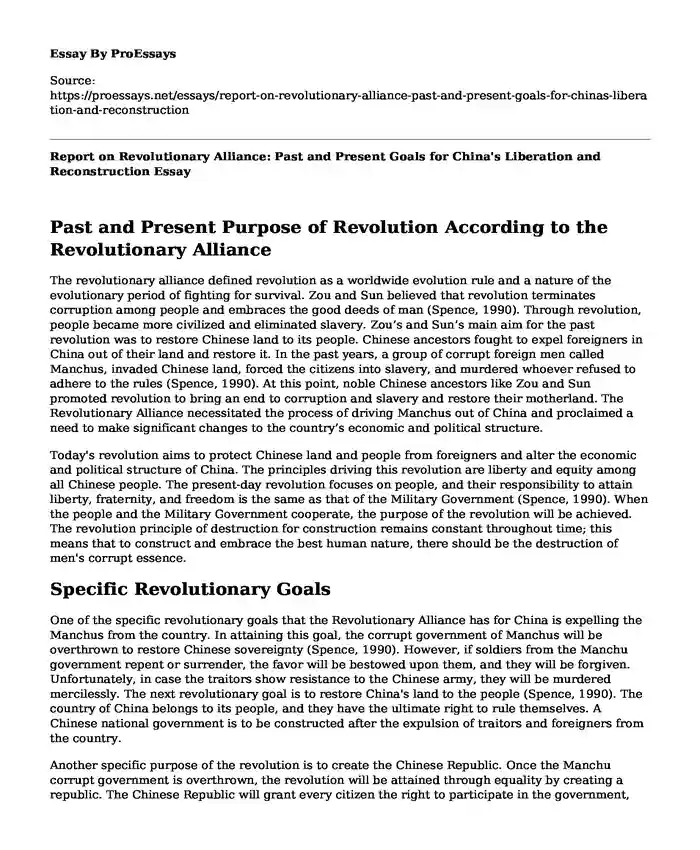Past and Present Purpose of Revolution According to the Revolutionary Alliance
The revolutionary alliance defined revolution as a worldwide evolution rule and a nature of the evolutionary period of fighting for survival. Zou and Sun believed that revolution terminates corruption among people and embraces the good deeds of man (Spence, 1990). Through revolution, people became more civilized and eliminated slavery. Zou’s and Sun’s main aim for the past revolution was to restore Chinese land to its people. Chinese ancestors fought to expel foreigners in China out of their land and restore it. In the past years, a group of corrupt foreign men called Manchus, invaded Chinese land, forced the citizens into slavery, and murdered whoever refused to adhere to the rules (Spence, 1990). At this point, noble Chinese ancestors like Zou and Sun promoted revolution to bring an end to corruption and slavery and restore their motherland. The Revolutionary Alliance necessitated the process of driving Manchus out of China and proclaimed a need to make significant changes to the country’s economic and political structure.
Today's revolution aims to protect Chinese land and people from foreigners and alter the economic and political structure of China. The principles driving this revolution are liberty and equity among all Chinese people. The present-day revolution focuses on people, and their responsibility to attain liberty, fraternity, and freedom is the same as that of the Military Government (Spence, 1990). When the people and the Military Government cooperate, the purpose of the revolution will be achieved. The revolution principle of destruction for construction remains constant throughout time; this means that to construct and embrace the best human nature, there should be the destruction of men's corrupt essence.
Specific Revolutionary Goals
One of the specific revolutionary goals that the Revolutionary Alliance has for China is expelling the Manchus from the country. In attaining this goal, the corrupt government of Manchus will be overthrown to restore Chinese sovereignty (Spence, 1990). However, if soldiers from the Manchu government repent or surrender, the favor will be bestowed upon them, and they will be forgiven. Unfortunately, in case the traitors show resistance to the Chinese army, they will be murdered mercilessly. The next revolutionary goal is to restore China's land to the people (Spence, 1990). The country of China belongs to its people, and they have the ultimate right to rule themselves. A Chinese national government is to be constructed after the expulsion of traitors and foreigners from the country.
Another specific purpose of the revolution is to create the Chinese Republic. Once the Manchu corrupt government is overthrown, the revolution will be attained through equality by creating a republic. The Chinese Republic will grant every citizen the right to participate in the government, elect the president, and elect parliamentary members who will represent the Chinese. There will also be the formulation of the republic’s constitution that will be followed by the citizens, and anyone who breaches it will face severe consequences (Spence, 1990). Finally, the reconstruction of the country's social, economic, and political structure will ensure that all Chinese have equal rights to own their motherland. Each piece of land will be evaluated to ensure fair valuation and distribution of land among the people, thus improving each individual's living standards and livelihood source.
Generally, the above goals will be executed in three steps: the military rule. Here, after the expulsion of traitor groups, Chinese all over the country will cooperate to ensure harmony, and the army will be subjected to military rule to cool down the chaos (Spence, 1990). The next stage will entail a provisional constitution where people will be given the right to elect their leaders and president. The last step will be a constitutional rule. The military government will execute its power by controlling its army, and the people will then elect their representatives and president.
References
Spence, J. D. (1990). The search for modern China. WW Norton & Company. https://www.goodreads.com/book/show/162556.The_Search_For_Modern_China
Cite this page
Report on Revolutionary Alliance: Past and Present Goals for China's Liberation and Reconstruction. (2024, Jan 09). Retrieved from https://proessays.net/essays/report-on-revolutionary-alliance-past-and-present-goals-for-chinas-liberation-and-reconstruction
If you are the original author of this essay and no longer wish to have it published on the ProEssays website, please click below to request its removal:
- Unravelling the Arabian Culture
- The Three Eras of Policing - Essay Sample
- Paper Example on Sudan's Comprehensive Peace Agreement
- Leadership Analysis: Martin Luther King Jr. Essay
- Native Americans & US Federal Govt: War, Opp., Defeat. Essay
- Competitive Advantage with Malcolm Baldrige National Quality Award - Essay Sample
- Free Essay Example: How Corruption Has Derailed Growth in Africa







